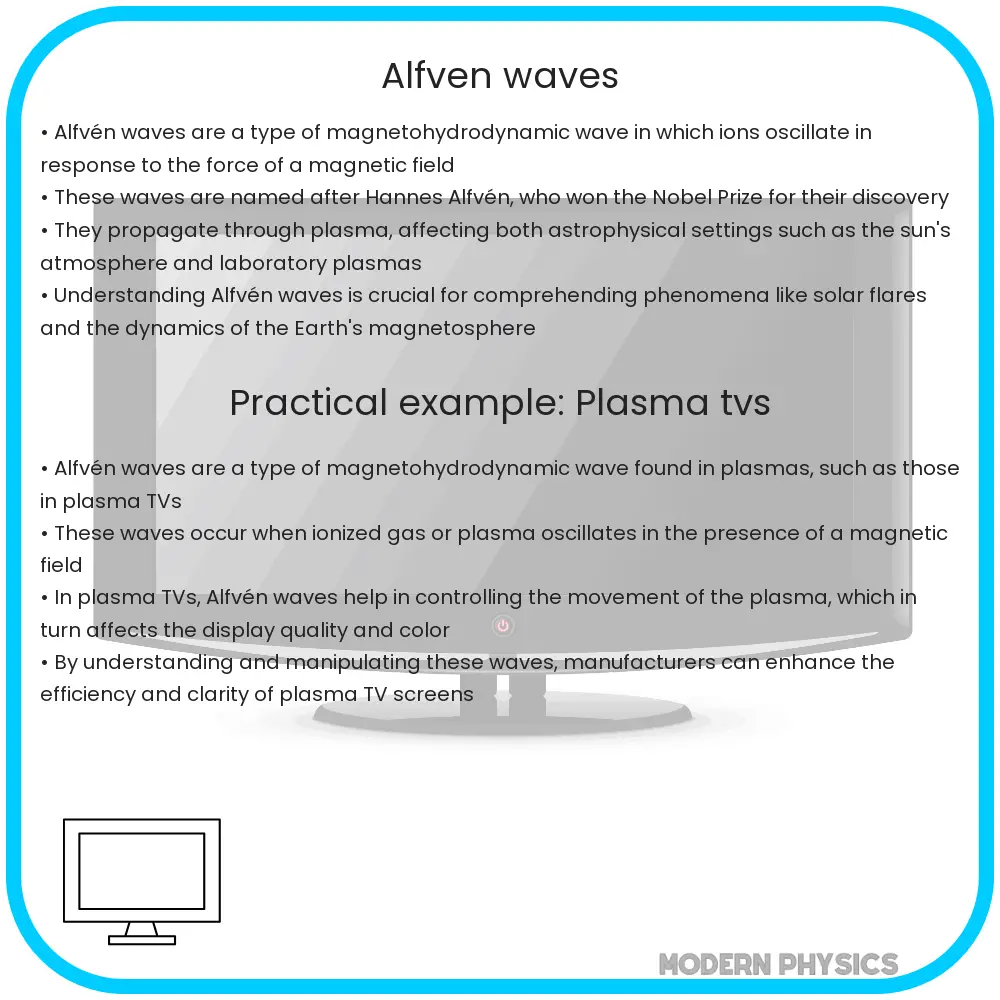Explore the fascinating world of Alfvén waves, key to understanding plasma dynamics in space and their applications in astrophysics, space weather, and fusion research.

Introduction to Alfvén Waves
Alfvén waves, named after the Swedish physicist Hannes Alfvén who first proposed their existence in 1942, are a fundamental type of magnetohydrodynamic (MHD) wave that occurs in magnetized plasmas. These waves are crucial in understanding the dynamics of space plasmas, including those in the Earth’s magnetosphere, the solar corona, and interstellar mediums. Alfvén waves are characterized by the propagation of magnetic tension forces through a plasma, behaving much like waves traveling along a stretched rubber band.
Key Concepts Behind Alfvén Waves
The propagation of Alfvén waves is governed by the interaction between plasma particles and the magnetic field. Unlike sound waves, which are pressure waves moving through a medium, Alfvén waves are transverse, meaning that the motion of the plasma particles is perpendicular to the direction of wave propagation. This unique behavior is described by the Alfvén speed, vA = B / √(μ0ρ), where B is the magnetic field strength, μ0 is the magnetic permeability of free space, and ρ is the plasma density. The Alfvén speed determines how fast the waves travel through the plasma.
Propagation of Alfvén Waves
Alfvén waves can propagate in both homogeneous and inhomogeneous plasmas and can be guided along magnetic field lines. This directional propagation makes them significantly important in the transfer of energy across different regions of a plasma environment. In the solar atmosphere, for example, Alfvén waves are thought to play a key role in the heating of the corona and the acceleration of the solar wind. Their ability to transfer energy efficiently over long distances without significant dissipation is a property that distinguishes them from other types of waves in plasmas.
Practical Uses of Alfvén Waves
Understanding and harnessing Alfvén waves has practical applications in various fields, including space weather forecasting, astrophysical research, and controlled nuclear fusion. In space weather, studying these waves helps scientists predict geomagnetic storms and their potential impact on Earth. In astrophysics, Alfvén waves are used to probe the dynamics of the solar corona and the interstellar medium. Furthermore, in the pursuit of controlled nuclear fusion, Alfvén waves play a role in stabilizing plasma confinement, a critical aspect of achieving sustainable fusion reactions.
Advanced Understanding of Alfvén Waves
The study of Alfvén waves extends beyond their basic properties to complex phenomena such as Alfvénic turbulence and wave-particle interactions. Alfvénic turbulence, a state of chaotic Alfvén waves, plays a significant role in the energy distribution across space plasmas, contributing to the heating of the interstellar medium and the solar corona. Wave-particle interactions, on the other hand, are key to understanding the acceleration of charged particles in space, which has implications for both space weather and astrophysical processes.
Challenges and Future Directions
Despite the advances in understanding Alfvén waves, several challenges remain. One of the primary issues is the difficulty in directly measuring these waves, especially in distant astrophysical plasmas. Current methods rely heavily on remote sensing and in-situ spacecraft observations, which can be limited by spatial and temporal resolution. Future research aims to improve these techniques, with developments in satellite technology and computational modeling expected to provide deeper insights into the behavior and effects of Alfvén waves across different plasma environments.
Another area of ongoing research is the interaction between Alfvén waves and other types of waves and instabilities in plasmas. These interactions can lead to complex dynamics that are not yet fully understood, highlighting the need for comprehensive theoretical models and sophisticated simulations to unravel the intricate physics governing these processes.
Conclusion
Alfvén waves represent a cornerstone in the field of magnetohydrodynamics, offering profound insights into the behavior of plasma in both space and laboratory settings. From their theoretical prediction in the early 20th century to their pivotal role in modern astrophysics and fusion research, Alfvén waves have proven to be a fundamental aspect of understanding plasma dynamics. The ongoing study of these waves not only deepens our knowledge of the universe but also holds the promise of practical applications in weather forecasting, astrophysical observation, and energy generation. As research continues to advance, the exploration of Alfvén waves is set to remain at the forefront of plasma physics, with the potential to unlock new technologies and enhance our comprehension of the cosmos.
